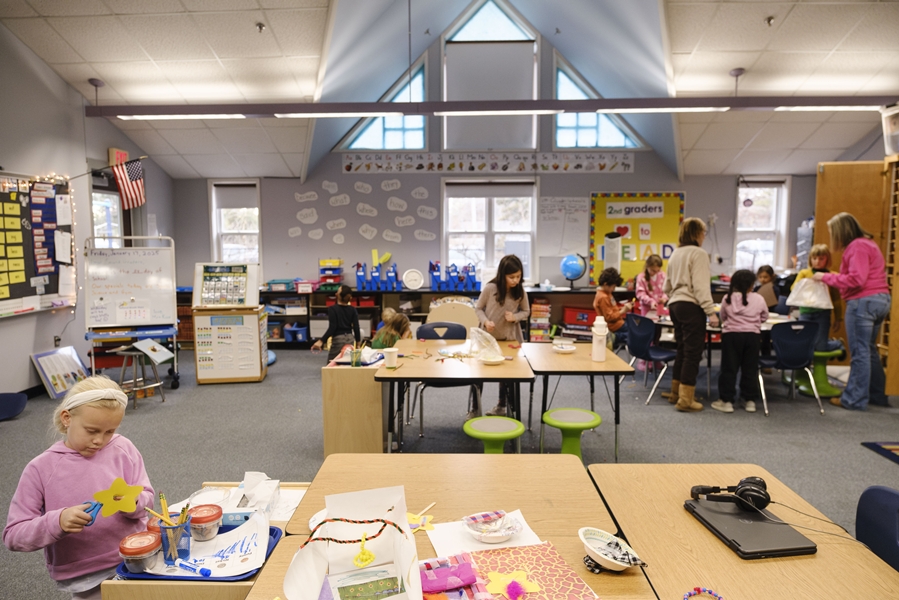This article was updated on Jan. 30, 2025.
WELLFLEET — With young families finding the Outer Cape increasingly unaffordable, elementary school enrollment has plunged by about 30 percent since the 2021-2022 school year in both Wellfleet and Truro, state Dept. of Elementary and Secondary Education data show. Over the same period, Eastham has seen a decline of 8 percent, while Provincetown’s enrollment has grown by 8 percent.

Wellfleet Elementary School (WES) currently enrolls 78 students in grades K to 5, while Truro Central School (TCS) has 79 students in preschool through grade 5.
Provincetown appears to have bucked the trend mainly by attracting students from other towns, including 39 elementary school students from Truro and Wellfleet.
The recent drop in Wellfleet and Truro is the largest since the early 2000s, when the Outer Cape’s elementary schools lost up to a third of their students from enrollment peaks in the late 1990s.
Despite this, regionalization does not appear to be a high priority for school officials. TCS’s strategic plan for 2023-2028 prioritizes sustaining the school’s current setup, and Wellfleet has thus far declined to participate in a study of potential regionalization of the Nauset district’s elementary schools.
The sharp downturn in enrollment in Wellfleet and Truro appears to be driven primarily by the loss of young families. According to state government data, the total number of school-attending children in each town has also dropped dramatically. Since 2020, Truro’s count of school-attending children has dropped by 24 percent, from 213 to 161. In Wellfleet, over the same period, the decline has been 17 percent, from 289 to 241.
Complicating matters further is school choice, which allows families in Massachusetts to send their children to a public school in a district other than the one in which they live. While some restrictions apply — students in one Nauset district elementary school may not choose another — the option represents a slow but more controllable leak next to an apparent gush of outmigration over the last three years.
WES Principal Adam O’Shea said low enrollment is “not all doom and gloom.” He pointed to mixed-grade special classes like art and music as a social opportunity for students and said small classes allow teachers to “cater to where the student needs are.”

O’Shea said he was working to keep families in the district by contacting those sending children to out-of-district elementary schools. While some families were attracted to Provincetown’s International Baccalaureate (IB) program, others sent children there because of transportation and child-care needs. In response, O’Shea said, WES has expanded its after-school program to 5:30 p.m. and opened it to students of all ages. O’Shea also said WES is doing more to celebrate its academic successes, including posting to a new Instagram account.
“Any student who’s living in Wellfleet, I want them to be attending Wellfleet’s school,” O’Shea said, adding that all kindergarten-age students in Wellfleet are currently enrolled at Wellfleet Elementary.
Even so, that class has only seven students. Keeping families who live in Wellfleet interested in sending their children to WES is something that individualized attention can influence, but keeping those families from leaving town altogether is a more challenging problem.
“This is the new normal,” O’Shea said, faulting the housing crisis. He hopes that the proposed affordable housing project at Maurice’s Campground and the one under construction at Lawrence Hill will attract families to Wellfleet. “Unless something big happens, I can’t see it shifting,” he concluded.
TCS Principal Patrick Riley said he knew of families that left midyear to move up-Cape; he also pins hope on affordable housing projects in Truro.
“We try to focus on what we can control,” said Riley. That means listening to families to develop offerings that meet their needs.
Though TCS technically offers 6th grade each year, the school’s 5th-graders usually move on to Provincetown or Nauset Middle School in Orleans. According to state data, TCS hasn’t had a 6th-grade class since 2022, when the class had only two students — though there were 18 fifth-graders the year before. But this year, Riley said, he approached TCS’s 5th-grade families early to get commitments to stay. The school will offer a “project-based, experiential model” for these students based on input from families for the coming year, though Riley would not say how many students he expected would sign up.
Eastham Elementary Principal Bill Crosby said he could not explain why Eastham was spared the steep decline that its neighbors to the north are experiencing. In just the last two months, he said, Eastham has enrolled nine new students. In spite of the housing crunch affecting the entire Outer Cape, he said, “they’re finding places to live.”
Ballooning Costs
The largely unspoken trend that accompanies declining enrollment is ballooning costs. In fiscal 2023, according to data from the state Dept. of Education, Provincetown spent $51,782 per student, Truro $51,816, Wellfleet $39,091, and Eastham $27,802. In Eastham, that figure represented a $1,139 increase from the previous year. Provincetown’s costs increased by about $5,300. In Wellfleet, the amount rose more than $6,600 from 2022 to 2023, and in Truro the increase was more than $7,000 from the previous year.

Provincetown Schools Supt. Gerry Goyette compiles cost data from towns across the Cape and Islands. He reported that in 2022 only Provincetown, Truro, Orleans, and Martha’s Vineyard Regional High School had per-pupil costs above $30,000.
“We’re at the tip of the Cape,” said Goyette. “Our number is going to be big. If I was in western Mass., I’d be very concerned about a $5,000 jump. And we’re worried about it here, but there’s certain costs that I can’t control.”
Ultimately, it’s voters who decide, and on the Outer Cape they tend to pass their school budgets year after year. Chris Easley, a Wellfleet resident and Nauset Regional School Committee member, said he couldn’t remember a time in his 10 years on the committee when a Nauset town had failed to pass a school budget.
“A vision for education can’t be financial,” he said. Even as costs climb, significant changes like regionalization should be focused on improving educational outcomes, not reducing costs, he added.
“You can’t say, ‘Look at all the money we’re going to save,’ ” Easley said. “You have to talk about ‘This is how the education is going to be better.’ ”
Further up-Cape, that conversation did start with cost concerns, however. Brewster and Orleans town managers spearheaded an effort to get a grant from the Mass. Community Compact Cabinet’s Efficiency and Regionalization program “to explore opportunities for improving efficiency and sustainability across the Nauset region’s elementary schools.” The substantial cost of bringing the current elementary school buildings up to code, rivaling the cost of new construction, was a significant motivator for that effort.
In December, Brewster Town Manager Peter Lombardi announced that Brewster, Orleans, and Eastham — three of the four Nauset district towns — had secured a grant of $150,000. Wellfleet, the fourth town, was conspicuously absent from the announcement.
Despite the Wellfleet Elementary School Committee’s approval of participation in the grant application in December 2023, Town Administrator Tom Guerino said the town had no funding for the study when he took over in February 2024, and he consequently declined to participate. Brewster, Orleans, and Eastham committed $100,000, $50,000, and $25,000 to the study respectively.
“We expect to start the project this spring,” Lombardi said in an email. “We remain hopeful that Wellfleet will decide to participate so we can have a full picture of the elementary school needs across the district.”
Asked whether Wellfleet would consider joining the study, Guerino said he would put it on the Feb. 4 select board agenda.
This is not the first time elementary school regionalization has been raised in Wellfleet. Jill Putnam, who retired last year after 33 years on the school committee, said talk of regionalization was what inspired her to run for a seat in the early 1990s.
“Cost effectiveness tends to be a motivating factor” in regionalization discussions, Putnam said. But in the end, she said, regionalization comes with unanticipated costs in transportation and administration. And with the smallest number of students, she added, Wellfleet would give up autonomy in deciding on spending priorities.
Easley said the time is “ripe” to start talking about big changes, but he wishes that the process were taking place through “community forums set up for that purpose.” This hasn’t happened, he said, because the district’s school committees are “underwater” with their own responsibilities.
Truro’s Strategy
In Truro, neither regionalization nor increasing school choice into the district appears to be a high priority. The town’s Strategy for District Improvement for 2023-2028 identifies “ensuring sustainability” as a goal, which it will accomplish through “the most effective use of resources” and working on “the sustainability of offering sixth grade at TCS.”

“We all share the same families across this region,” said TCS Principal Riley. “We’re not trying to be overtly in direct competition with each other.”
In contrast, Provincetown’s Goyette said, “There’s x amount of children on the Outer Cape. We’re all jockeying for those students.”
After a nadir of 97 students in 2011-2012, Provincetown’s enrollment has grown in 11 of the 13 ensuing years, “and we’re not growing because more children are moving into Provincetown,” Goyette said.
Unlike other towns, Provincetown has made increasing its school choice numbers an explicit goal. Its strategic plan for 2023-2028 — which must be unique in opening with a Frank Zappa quote (“A mind is like a parachute; it doesn’t work if it is not open”) — calls on the schools to “recruit and retain students and parents through advertising, open houses, and parent outreach,” from which it hopes to gain four or five new students per year.
According to Administrative Assistant Judy Ward, there are more school choice students in Provincetown’s schools, 84, than local students, 67. The choice students include 32 from Truro, with 28 at the elementary level, and 11 elementary students from Wellfleet.
Marin Reinhardt of Eastham is the mother of three Provincetown school choice students. In 2019, a broker for a house in Truro she was looking at suggested that her kids could go to Provincetown instead of TCS.
“It might be a little more like a private education than a public education — but not paying for a private education,” she said. In 2021, she said, looking for work as a substitute teacher, she was impressed with the rapport among the staff and students in Provincetown. The family decided to make the switch.
“It’s not that Eastham Elementary was a bad school,” Reinhardt said. Her husband fishes for lobster out of Provincetown, so the family spends a good amount of time there anyway.
Overall, Reinhardt said, she likes the Provincetown Schools location and integration with a dense, close-knit community.
“The other towns feel very rural,” she said.
Editor’s note: Because of a reporting error, an earlier version of this article, published in print on Jan. 30, included incorrect figures for the increase in per-student costs from fiscal 2022 to 2023 in Truro, Wellfleet, and Eastham. In Truro, the increase was about $7,000, not $17,780; in Wellfleet, the increase was about $6,600, not $8,000; and in Eastham, the increase was $1,139, not $3,000.



